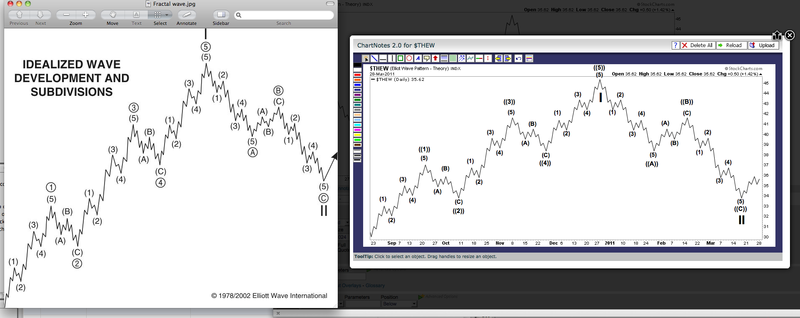There are several new indexes at StockCharts.com that everyone should check out. They are our new "Theory" indexes that contain artificial, idealized versions of four important chart patterns - a sawtooth reversal pattern ($THSAW), a sine wave pattern ($THSINE), a "perfect" Elliott Wave pattern ($THEW), and a good approximation of an "ideal" Head and Shoulders reversal pattern ($THHS).
Here's a comparison of an annotated version of $THEW along with a snapshot of an "ideal" Elliott Wave taken from our friends at ElliottWave International:
As you can see, $THEW is extremely similar to the version of EWI. The image on the right also demonstrates our recent "Elliott Wave Annotations" tool that is now built into ChartNotes. The numbers and letters on that chart were added very quickly just using single clicks of the mouse.
It's important to keep in mind that all of our Theory indexes (i.e., indexes that start with "$TH") are artificial. They are there to help you study indicator behavior. They are not tradable. They do not represent actual indexes or securities of any type. So what good are they? Here are just some of the things you can do with them:
1.) Watch how the patterns develop over time
Each day we add a little bit more of the pattern to the right side of the chart. Remember, the right side is where everyone has to live in order to make money. So what does a Head and Shoulders pattern look like as it is emerging? Now you can see with $THHS.
2.) Watch how different indicators behave as the patterns develop
Can a MACD be used to confirm the development of a perfect Ellott Wave pattern? What does the Aroon indicator look like during a rounding top? How do Bollinger Bands behave near the right shoulder of a Head and Shoulders pattern? All of these questions (and many more) can be easily answered with our $TH indexes.
3.) Compare current stock behaviors to the ideal
Overlay $THEW on top of the chart of a real stock to see how it compares to the "ideal" Elliot wave pattern. Ditto for all of our other $TH charts.
Let me know if you discover something else wonderful you can learn for these things.
- Chip







